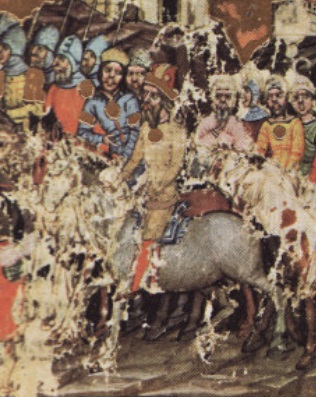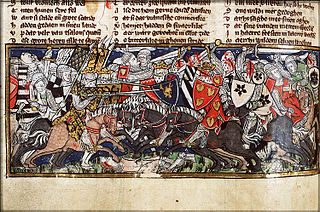Related Research Articles

Bleda was a Hunnic ruler, the brother of Attila the Hun.
Mundus or Mundo was a Barbarian commander of Gepid, Hun, and/or Gothic origins. He appears to have been the son of the Gepid king Giesmus. In the early 500s he commanded a group of bandits in Pannonia, eventually allying himself to the Ostrogothic king Theodoric the Great. After Theodoric's death in 526, Mundus entered Byzantine service under emperor Justinian I, fighting in the Balkans, defending Justinian during the Nika riots, and fighting in the first stage of the Gothic War, during which he died in 536.

Onegesius was a powerful Hunnic logades (minister) who supposedly held power second only to Attila the Hun. According to Priscus he "seated on a chair to the right of the king" i.e. Attila.
The Hunnic language, or Hunnish, was the language spoken by Huns in the Hunnic Empire, a heterogeneous, multi-ethnic tribal confederation which invaded Eastern and Central Europe, and ruled most of Pannonian Eastern Europe, during the 4th and 5th centuries CE. A variety of languages were spoken within the Hun Empire. A contemporary report by Priscus has that Hunnish was spoken alongside Gothic and the languages of other tribes subjugated by the Huns.
Mundzuk was a Hunnic chieftain, brother of the Hunnic rulers Octar and Rugila, and father of Bleda and Attila by an unknown consort. Jordanes in Getica recounts "For this Attila was the son of Mundzucus, whose brothers were Octar and Ruas, who were supposed to have been kings before Attila, although not altogether of the same [territories] as he".
Attila is a popular masculine name in Central and Eastern Europe, Southeastern Europe and Western Asia. Primarily in Hungary, Turkey, Bulgaria and Chuvashia. Attila is the most used version in Hungary, however another version of Attila is Atilla and Etele, the female equivalent of which is Etelka. Attila is used as Atilla in Turkish.
Ernak was the last known ruler of the Huns, and the third son of Attila. After Attila's death in 453 AD, his Empire crumbled and its remains were ruled by his three sons, Ellac, Dengizich and Ernak. He succeeded his older brother Ellac in 454 AD, and probably ruled simultaneously over Huns in dual kingship with his brother Dengizich, but in separate divisions in separate lands.
Rugila or Ruga, was a ruler who was a major factor in the Huns' early victories over the Roman Empire. He served as an important forerunner with his brother Octar, with whom he initially ruled in dual kingship, possibly a geographical division where Rugila ruled over Eastern Huns while Octar over Western Huns, during the 5th century AD.
Dengizich, was a Hunnic ruler and son of Attila. After Attila's death in 453 AD, his Empire crumbled and its remains were ruled by his three sons, Ellac, Dengizich and Ernak. He succeeded his older brother Ellac in 454 AD, and probably ruled simultaneously over the Huns in dual kingship with his brother Ernak, but separate divisions in separate lands.
Charaton was one of the first kings of the Huns.

Uldin, also spelled Huldin is the first ruler of the Huns whose historicity is undisputed.

Ellac was the oldest son of Attila (434–453) and Kreka. After Attila's death in 453 AD, his Empire crumbled and its remains were ruled by his three sons, Ellac, Dengizich and Ernak. He ruled shortly, and died at the Battle of Nedao in 454 AD. Ellac was succeeded by two of the three brothers, Dengizich and Ernak.
By the name Edeko are considered three contemporaneous historical figures, whom many scholars identify as one:

Kreka or Hereka was the wife of Attila. She was described by Eastern Roman diplomat Priscus in his account of his stay at Attila's court in 448 or 449 AD. She and Attila had three sons: Ellac, Dengizich, and Ernak, who split among themselves what remained of Attila's empire after his death in 453.

Balamber was ostensibly a chieftain of the Huns, mentioned by Jordanes in his Getica. Jordanes simply called him "king of the Huns" and writes the story of Balamber crushing the tribes of the Ostrogoths in the 370s; somewhere between 370 and more probably 376 AD.

Laudaricus was a prominent Hunnic chieftain and general active in the first half of the 5th century.
The history of the Huns spans the time from before their first secure recorded appearance in Europe around 370 AD to after the disintegration of their empire around 469. The Huns likely entered Western Asia shortly before 370 from Central Asia: they first conquered the Goths and the Alans, pushing a number of tribes to seek refuge within the Roman Empire. In the following years, the Huns conquered most of the Germanic and Scythian tribes outside of the borders of the Roman Empire. They also launched invasions of both the Asian provinces of Rome and the Sasanian Empire in 375. Under Uldin, the first Hunnic ruler named in contemporary sources, the Huns launched a first unsuccessful large-scale raid into the Eastern Roman Empire in Europe in 408. From the 420s, the Huns were led by the brothers Octar and Ruga, who both cooperated with and threatened the Romans. Upon Ruga's death in 435, his nephews Bleda and Attila became the new rulers of the Huns, and launched a successful raid into the Eastern Roman Empire before making peace and securing an annual tribute and trading raids under the Treaty of Margus. Attila appears to have killed his brother and became sole ruler of the Huns in 445. He would go on to rule for the next eight years, launching a devastating raid on the Eastern Roman Empire in 447, followed by an invasion of Gaul in 451. Attila is traditionally held to have been defeated in Gaul at the Battle of the Catalaunian Fields, however some scholars hold the battle to have been a draw or Hunnic victory. The following year, the Huns invaded Italy and encountered no serious resistance before turning back.
Basich or Basikh was a Hun military commander who co-led an invasion of Persia in 395 AD together with Kursich.
Kursich was a Hun general and royal family member. He led a Hunnish army in the Hunnic invasion of Persia in 395 AD.
Eskam was Hun living in 5th-century Pannonia, then under the Hunnic Empire. He was possibly a shaman. His daughter was one of the numerous wives of Attila the Hun.
References
- 1 2 3 4 5 Pritsak 1982, p. 440.
- ↑ Maenchen-Helfen 1973, p. 381.
- ↑ Maenchen-Helfen 1973, p. 441.
- 1 2 3 Maenchen-Helfen 1973, p. 81.
- ↑ Maenchen-Helfen 1973, p. 85.
- ↑ Maenchen-Helfen 1973, p. 85–86.
- ↑ Maenchen-Helfen 1973, p. 83.